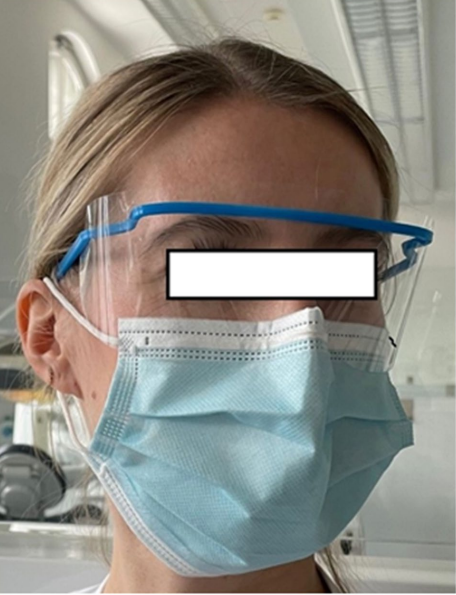An interesting article titled “Blood and saliva contamination on protective eyewear during dental treatment,” written by Nora Bergmann and et al. appears in the 2022 edition of Clinical Oral Investigations (Feb. 14, 2022). The article sought to explore the amount of aerosols, blood and saliva splashes on protective eyewear worn during dental treatments. The authors also looked at the effectiveness of disinfection of the eyewear.
In the study the authors used forensic techniques to analyze 53 protective eyewear shields worn by dental staff during aerosol-producing dental treatments. The protective eyewear were worn during dental treatments like supragingival cleaning, carious cavity preparation, and subgingival periodontal instrumentation. To detect blood contamination, luminol was applied on the surface of the eyewear shilds.
The authors found that a macroscopically detectable amount of contamination was found on 60.4% of the protective eyewear shields that had been worn during these dental treatments. Of the dental procedures, the highest amount of blood was found to be splattered on the protective eyewear was after the dental team used air scalers to perform teeth cleanings. The next highest amounts of blood found to be splattered on the protective eyewear was after the dental team was after the dental team performed scaling and root planing. Endodontic and restorative therapy procedures rounded out the top three and four procedures with the most blood splattered on the protective eyewear but in much lower amounts than the first two highest types of procedures already mentioned. The authors found no difference in blood splattered on protective eyewear amongst women vs men or left-handed vs right-handed study participants. The authors state:
“In the present study, the highest contamination was found after the use of air scaler, used in professional teeth cleaning and periodontal therapy…”
When it came to salivia detection on the protective eyewear, the highest amounts were found after the dental teamtn used air scalers to perform teeth cleanings. However, there was not statistically signficant difference found between the dental treatments for salivia detection.
The authors state:
“…a signifcant contamination with blood and saliva on protective eyewear was detected after dental treatment….To prevent the conjunctiva from blood and saliva splashes, adequate protection of the eyes is necessary for the dental professionals.”
After disinfecting the protective eyewear shields the authors found that they contained 0.02% blood contamination and no saliva contamination. They consider this effective and nearly free of blood.

The authors consider that because of infectious diseases, caused by blood or airborne microorganisms, dental teams wearing protective eyewear shields to protect against aerosols and splashes should be required. A heightened awareness of this need has been made due to the COVID-19 pandemic and the rise of use of personal protective equipment. Since dental teams are at high risk of COVID-19, dental teams should add protective eyewear as personal protecteive equipment.
The authors mention a few limitations of their study including that disposable shields were disinfected and resued like normal reusable shields due to being a pilot study and wanting to test detection under standardized conditions. Further the majority of the participants in the study were actually dental students who may have been physically closer to the patients they were treating than of those more experienced dental staff and dentists which could have resulted in higher contamination. The authors also pointed out that while their statistical power calculation showed a minimum of 43 protective eyewear shields, which was under the amount they used in the study of 53, a higher sample size could have helped to further validate their results.
